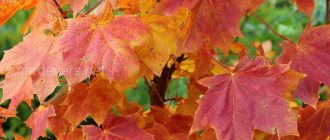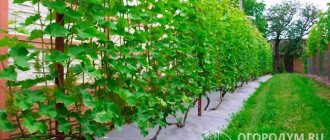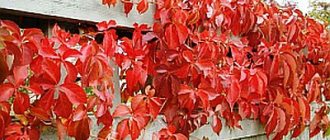Today, girlish grapes can be found in literally every vacant lot. But not every gardener will decide to invite irrepressible girlish grapes to his small plot. And many even have to fight the vine, like a malicious weed. However, Polish and American breeders made the maiden grape desirable again, giving its leaves an unusual color and taming its willful temper. I will tell you about the most decorative and completely non-aggressive species and varieties of virgin grapes that grow on our site in this article.
My varieties of girlish grapes are decorative and docile
Now it’s difficult to remember who and why came up with the idea of calling girl’s grapes “wild.” Perhaps the reasons for this lie in the unbridled nature of this vine, which grows at a stunning speed. Or maybe rumor has decided that this is a natural variety of cultivated varietal grapes. However, the scientific name of the “wild” grape is Parthenocissus, and it is a completely independent genus of the grape family.
Wild grapes, description and features
Maiden grape is a vine characterized by an abundance of foliage and the ability to grow quickly. The leaf cover serves as the basis for the decorative effect of the plant: bright, wide leaves of complex shape add a rich green color to the landscape. And in the fall, climbing grapes look even more elegant, thanks to the variety of colors.
Wild grapes have many names. One of the most common is maiden (virgin), it was given for its ability to self-pollinate. This plant is also known under the names Maiden's tears, Women's or Lady's grapes.
The vines of the plant, depending on the variety, can grow to a length of 15 m. At the same time, they cling tightly to the surface with tendrils, so that it is easier to break off the shoot than to unhook it. Thanks to such creeping and tenacity, girlish grapes do not need additional supports. They may be needed only in the early stages of a seedling’s life, until it reaches a fence or wall.
Maiden grapes
At the beginning of autumn, small dark berries appear on the grapes, a favorite delicacy of birds.
Important! The berries are not suitable for food: wild grapes, like indoor grapes, are grown solely for beauty.
Unlike cultivated grape varieties, wild ones are not afraid of frost. Many do not require shelter for the winter: snow is enough for them.
Another advantage is the possibility of planting in shaded areas. Climbing grapes take root well on the north side of the house, in the shade of a solid high fence. Cultivated forms of the plant cannot boast of such resistance.
Creeping grapes very rarely suffer from insect attacks and diseases. Therefore, it does not require spraying or seasonal tillage.
Note! The deciduous plant does not lose its decorative appearance even in winter: dark lashes stand out against the background of snow, representing a bizarre “web” on the braided surface.
Cissus: can you keep it in the house - useful properties and signs
Thanks to the high bacterial and phytoncidal activity of the indoor flower, the atmosphere in the home is cleansed. Microcomponents released by cissus kill bacteria that cause allergic diseases and gastrointestinal disorders.
Decorative vine perfectly humidifies the air in the room and absorbs excess dust.
Helps get rid of formaldehyde - fumes from building materials, which often cause headaches, provoke nausea, and irritate the respiratory system.
Several pots of plants in the room increase vitality and reduce fatigue.
Popular signs and superstitions associate the cissus flower, like most lianas, with a muzhigon flower, that is, the flower is capable of surviving a spouse from home. Whether or not to keep hanging plants at home is up to everyone to decide for themselves; most flower growers do not pay attention to these myths.
Types and varieties
There are two main varieties of wild grapes: five-leaf and tri-leaf. They can be distinguished by the shape of the leaf, which becomes clear from the name.
Girlish grapes on the balcony
The first one came to us from North America. This unpretentious species is capable of producing long shoots (up to 30 m), capable of climbing up a steep surface. The leaves are palmately compound, pointed at the tips. They differ from the triacid ones in a darker shade. The fruits of the five-leaf grape are small and black. Not suitable for food!
The following varieties are widespread:
- Star Showers, also known as Variegated Leaves, is known for its marbled pattern on its leaves;
- Don Juan, striking the imagination with the purple color of the leaves in autumn;
- Hairy, with slight pubescence;
- Wall loach, easily attached to vertical surfaces.
Five-leaf grapes are grown on balconies, used as home decoration, or formed into a hedge.
The tripointed type of creeping grape came to us from the territories of Japan and China. Under natural conditions it grows among rocks, tightly entwining them. It is sensitive to cold. In areas with frosty winters, from the Moscow region to the Urals, you will have to take care of winter shelter.
This is interesting! A decoction of twigs of wild triostpicious grapes is used in folk medicine as a hemostatic agent.
The plant's vines are long, up to 40 m. They are equipped with tenacious tendrils with suckers. Densely leafy. Does not require additional supports. The leaves are rich green, turning red in autumn.
The fruits are inedible, dark, covered with a bluish coating.
Among the most common varieties are Green Spring, characterized by large leaves, and the small-leaved Vicha variety.
Tripointed grapes are also good as an hanging plant, forming hedges, and decorating balconies.
Origin
The plant belongs to the genus of lianas and is distributed in many countries - North America, East Asia, and the Himalayas.
The most common of them is the five-leaved, or virginian, species. It has been used to decorate architectural structures since ancient times, but gained its greatest popularity in the 17th century.
Aristocrats decorated it with maiden grapes, and they were also planted in squares and parks - buildings entwined with leaves looked very picturesque.
Legend has it that one of the elements of the famous Hanging Gardens of Babylon was maiden grapes.
After some time, he turned the stone terrace into a real work of art.
Use in landscape design
Maiden grapes planting and care
The use of creeping ornamental grapes for landscaping and beautifying a site is carried out in several ways.
- Formation of a hedge. Capable of climbing on almost any surface, ornamental grapes quickly entwine wooden fences or chain-link mesh, so that in summer they are not visible under the leafy carpet. You can also use decorative grapes for zoning the area. It is worth remembering that strong vines can damage fences that are too old and dilapidated.
Forming a hedge
- Vertical gardening. For beautifying various structures, buildings, arches, gazebos or canopies, wild grapes are one of the best options. Its tenacious antennae reliably attach to vertical surfaces, and its intensive growth helps cover a large area.
Vertical gardening.
- Decoration of balconies and loggias. Greenery enlivens balcony partitions and adds pleasant cool shade. The grapes take root well in containers, growing and delighting with fresh foliage until autumn.
Attention! To prevent the lashes from damaging the plastered walls, it is advisable to lay a mesh as an additional support.
Planting girlish grapes
Maiden grapes in landscape design
The plant is propagated by cuttings or layering. However, it is possible to grow Dame grapes from seeds. But this is a complex process that requires special skills.
The optimal time for planting is in April-May, but planting before winter, in September-October, is also quite effective.
Planting seedlings obtained by cuttings is carried out as follows:
- A hole measuring 60x60 cm is prepared. The distance between adjacent holes should not be less than 30 cm.
- Drainage is laid (crushed stone, pebbles, sand) in a layer of 20 cm.
- Peat or humus is added to the hole. This is not a necessary step; the grapes take root well in ordinary garden soil.
- The shoot is pruned, leaving 4 buds.
- The resulting cutting is placed in a hole and sprinkled with soil, burying the 2 lower buds into the soil.
- Plantings are watered and covered, protecting from the sun.
- After rooting, the protection is removed.
You can root a long vine from a mature plant. To do this, a 2-meter shoot is cut off, buried 2 cm into the soil and watered abundantly. Soon roots will appear on the nodules. After this, they can be divided into short cuttings and planted according to the above scheme.
Reproduction
A gardener, if desired, can easily and quickly increase the number of plantings. The undoubted advantage of the culture is simple propagation: by cuttings or layering. You can also use the seed method, but then you will have to resort to stratification and growing seedlings.
By layering
On an adult plant, a suitable lash is selected in the spring. Dig a groove and lay the shoot, carefully covering it with earth. During the summer, water the vine, securing it to the ground with wooden or wire staples for reliability.
By September, rooted cuttings are cut, dug up and planted in a chosen place on the site. For the winter, it is advisable to protect young bushes from frost.
Cuttings
Almost all methods are suitable for summer residents without experience. Many people practice propagation by cuttings in the spring. To begin with, choose strong and healthy shoots from the bushes and cut them into pieces.
4-6 buds are left in each. Prepare a small bed, dig holes and place the cuttings, deepening them a couple of buds into the ground. Moisturize well and sprinkle with earth.
In the summer, they take care of the plantings and make sure that the soil does not dry out. By autumn, the cuttings will take root, so all that remains is to carefully dig up and plant the seedlings in a permanent place.
On a note! In the first weeks after transplantation, it is advisable to shade the cuttings from the bright sun.
Seeds
The method is troublesome and requires stratification. Seeds are obtained from ripened berries in the fall by removing the pulp and drying them in air. Store in bags until the end of winter.
Then the seeds are placed in boxes or containers with damp sand. They are kept for 1-1.5 months at a temperature of +5 ºC, after which the seeds should hatch. This is a signal that the grapes are ready to plant.
Sow in separate cups or pots and place on a light windowsill. Standard care: watering, loosening. Planted on the site when consistently warm weather arrives.
Root suckers
Maiden grapes take root quickly, so it is not difficult to propagate it using root shoots. The liana, in contact with the surface of the earth, produces roots.
If you need to quickly get young seedlings, you can use this method. After rooting, the bush is separated from the mother plant and planted in the chosen location. They also work with young shoots surrounding mature bushes.
Nuances of care
Despite the unpretentiousness of girlish grapes, you still need to care for them.
Just a few simple procedures will help support the development of shoots and protect them from possible diseases:
- In May-June, you can apply 50 g of mineral complex fertilizers to each bush. After a couple of months, the procedure is repeated.
- Wild grapes do not need regular watering. If the summer turns out to be dry, you can pour 2 buckets of water under each root. This should be done approximately once a month.
- A plant that stretches upward sometimes has its roots exposed. In such cases, fresh soil is poured under the bush and hilling is carried out.
Grapes of the Maiden's Tears variety feel great without pruning, but it is still worth pruning in order to increase decorativeness.
Need to look after him
The plant is pruned for the first time in early spring. At this time, dried, damaged shoots are removed, or those that block the view, stretch onto the porch, or crawl under the roof.
In the summer, you can carry out a second formative pruning, removing shoots that block the entrance to the gazebo or interfere with the growth of other plants on the site.
In September, the most overgrown shoots are cut off and the dried ones are removed.
The tough vines of wild grapes are inedible to insects. Rodents also do not feed on them, however, they can sneak through them into their homes. Therefore, it would be a good idea to periodically place bait for rodents at the roots of the plant.
The leaves of this variety of grapes are also not threatened by anything: insect pests are indifferent to them. They are attacked only by aphids, which can be gotten rid of in various ways. The plant is treated with a soap solution mixed with alcohol in a ratio of 3:1 or any effective insecticide used on fruit trees.
Let's sum it up
Decorating a plot with grapes is not an original idea, but it is consistently attractive to almost all gardeners. From the technical side, there are no problems with this design.
The main difficulties arise in drawing up a decor project, since the rapid growth of plants does not allow the results to be preserved for a long time. However, if you make constant corrections, you can stabilize the design of the site and maintain it in the desired form.
Previous
Questions and answersGrapes and health: the benefits of berries, seeds and leaves for humans, possible negative consequences
Next
Growing and careAll about feeding grapes: fertilizers, equipment, seasonality
Possible uses of the fruit
Wild grape berries growing in clusters are considered poisonous by many. In fact, this opinion is wrong; they are edible. The fruits are simply very tasteless, as you can see by trying one of them. And poisoning can only occur if you consume an excess amount of berries. However, cases of such poisoning have not yet been recorded: no one voluntarily eats tasteless berries.
Despite the unflattering description of their taste, the fruits of wild grapes have established themselves as a good traditional medicine that helps with certain diseases.
The beneficial properties of these fruits are due to the content of certain substances in them, such as:
- dextrose;
- pectin;
- tartaric, malic and citric acids.
Proponents of traditional medicine advise taking products based on wild grape fruits in the following cases:
- diarrhea;
- disturbances in the gastrointestinal tract;
- deterioration of metabolism;
- increased acidity of gastric juice.
Wild grapes are also useful for improving blood composition and the formation of blood cells.
Attention! The seeds of virgin grapes also bring benefits: oil and vinegar are produced from them.
Graceful vines of wild grapes will enliven any corner, making it cozy and original. This makes it a real boon for landscape design. And the ease of care and unpretentiousness of this plant will save owners from unnecessary hassle. Although inedible berries will not decorate homemade dishes, they will be useful in the fight against disease.
0 0 votes
Article rating











